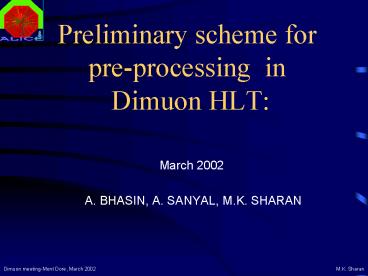Preliminary scheme for preprocessing in Dimuon HLT: - PowerPoint PPT Presentation
1 / 20
Title:
Preliminary scheme for preprocessing in Dimuon HLT:
Description:
Understanding of QGP with quarkonia find threshold like behavior ... F.M. algo for 85 Hijing Evts. ( CPU time in seconds) M.K. Sharan ... – PowerPoint PPT presentation
Number of Views:19
Avg rating:3.0/5.0
Title: Preliminary scheme for preprocessing in Dimuon HLT:
1
Preliminary scheme for pre-processing in
Dimuon HLT
- March 2002
- A. BHASIN, A. SANYAL, M.K. SHARAN
2
Outline
- Physics Motivation
- Data rates
- for dimuon and TPC
- DAQ/HLT architecture
- Preliminary scheme
- Algorithm of F. Manso
- Results on different machines
- Hit finding
- Next steps
3
Physics Motivation
- Understanding of QGP with quarkonia find
threshold like behavior - Yields vs. centrality measurement by getting
information from other detectors along with
dimuons, - ZDC, FMD, PHOS, PMD, Silicon Pixels
- As a function of pT ? High pT correlations for
distangling QGP models
4
Data Rates for Pb-Pb
- I) Dimu 1 Data from ITS pixels, Muon spectro,
PMD, - PHOS, FMD ZDC
- Event Size .35 Mbytes
- II) Dimu 2 Data set from Dimu 1 along with ITS
Drift, ITS Strips - Event size 1.46 Mbytes
- Trigger Rates Hijing 8000 (Hijing
Standard) - Low pt cut 1600 Hz (650
Hz) - High pt cut 450 Hz (90
Hz) - Ref. E. Vercellin,
Cagliari meeting, May 2001
5
Data throughput
- Scenario A. - p-p collisions
- Scenario B. Pb Pb collisions Only Dimu1 data
set - Data throughput 280
Mbytes/sec - Simple daq scheme for 1st
year of data taking. - Scenario C Pb-Pb collisions
- Dimu1 Dimu2 data sets
- Data throughput 530
Mbytes/sec
6
Data Rates for TPC Dimuon
7
DAQ / HLT hardware architecture
- Scenarios for the DAQ HLT systems
- Scenario A DAQ for acquisition of raw data only
- Scenario B HLT mechanism inserted, raw data
untouched - Scenario C DAQ and HLT with full functionality
8
DAQ / HLT Layout
Detector readout electronics
DDL SIU
DDL
LDC
DDL DIU
HLT Network
RORC
HLT node
DAQ Network
GDC
Mass Storage Servers
9
DAQ Layout (Scenario A)
DDL
DDL
DDL
DDL
DAQ Network
10
DAQ HLT (Scenarios B,C)
HLT Network
HLT farm
DAQ Network
GDC
11
General scheme
ITS
L0
Dimuon Trigger
PMD
Global Trigger
Readout Dimuon
PHOS
Zero Supressed Data
Hit Finding
Trigger Data
Track selection
ROUTES
HLT NODE
DAQ NETWORK
12
ROUTES
- Muon trigger detectors are fast
detectors(decision within 500 nsec) compared to
tracking detectors . - Use the information to define Routes in
different chambers - How information from trigger detector is
transmitted --Protocol to be defined (Do u take
decision in LDC/RORC ??)
13
Hit finding
- This job requires the maximum processing time
- Time it takes to do clustering on aliroot using
Gatti formula(1GHz, 350MHz, dual CPU machine) - Centre of gravity method should be good enough
for online analysis Needs to be tried - Compare for performance in, Aliroot stand alone
c code, hardware (FPGA perhaps)
14
Track reconstruction
- Evalulation of various pattern recognition
algorithm To find the best candidate for track
reconstruction. - Checking the timings for track reconstruction of
algorithms both in software hardware. - An alternative algorithm for track
reconstruction - Hough transformation e.g. TPC,
ATLAS NOT Necessary for
dimuons.
15
Status
- Franck Mansos algorithm Filtering and uses the
hit information from stations 4 5 to improve
the pT resolution and hence the pT cut Helps in
reducing the background(Pb-Pb central collisions)
by factor of 5. - We have tested the algorithm on different
machines and the time required for 85 background
events (Hijing 8000) in Aliroot vs. 3.04, root
version 2.25
16
F.M. algo for 85 Hijing Evts. (CPU time in
seconds)
17
Clustering on Stations 4 5 per event(CPU time
in seconds)
18
Conclusions
- Hit finding takes maximum access time. Algorithm
to be optimised. In built parallelism can be
utilized in multi CPU machines. - Algorithm scales with chip speed
- Need to define how information from trigger
chamber is made available for pre-processing
19
Next steps
- Dimuon HLT
- Key issues physics simulation and HLT algorithms
- Code for Hit finding- Benchmark it on Aliroot,
Test its performance. - Test it in Alice DATA Challenge
20
References
- DAQ scenarii for the muon arm E. Vercellin
- Dimuon meeting Cagliari, May 2001
- DAQ Document P.V.V
- ALICE-INT-2000-30
- Alice HLT Conceptional Design Report Volker
Lindestruth D. Rohrich, July 2001 - Dimuon HLT-interfaces to DAQ - PVV Alice Week,
New Delhi, 2001 - A first algorithm for a dimuon High Level
Trigger- - F. Manso, ALICE-INT-2002-04































